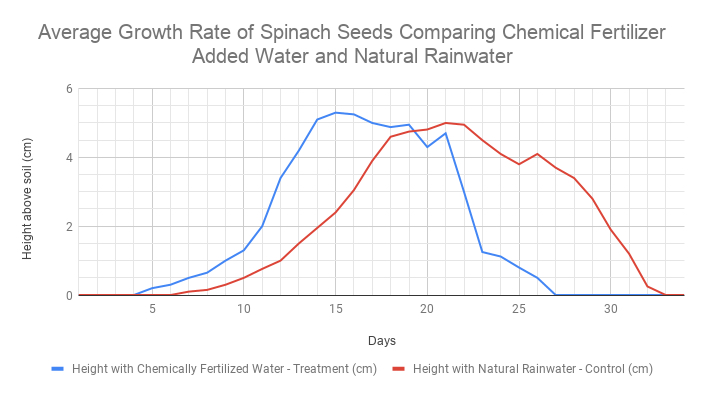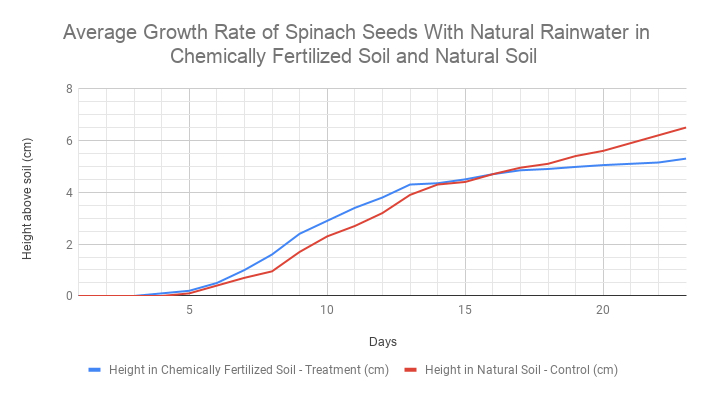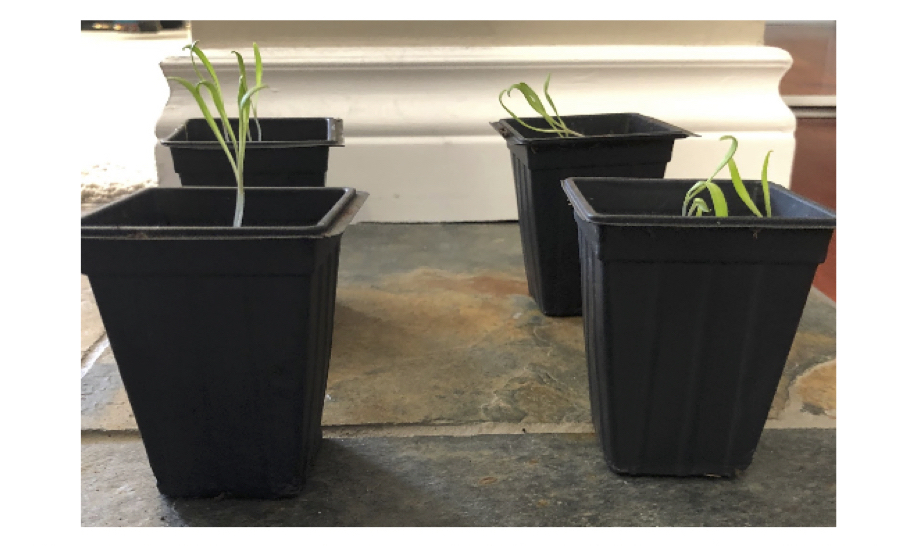Helen Zhang, Future Science Leaders.
Abstract
Chemical fertilizer was largely used in farmlands to increase yield and protect plants from pests, however, some people remained unaware of the negative effects on the soil fertility. This experiment was conducted to compare the plant growth in soil with chemical fertilizer and without. Two groups of spinach seeds were planted with different treatments to compare the growth rate and another two groups were planted in the same soil after the death of the first group to compare the growth rate again. After graphing the numbers from the experiment, the results showed that chemical fertilizer could increase plant growth but could also create long-term negative effects on soil fertility. The results could act as a reminder to farmers and gardeners to be more careful when using chemical fertilizer and promote natural and sustainable farming.
Introduction
Population growth is a vital topic to humans as birth rate increases, and the direct link to this topic is the idea of food production (Harley). Malthusianism is a theory stating that the population grows exponentially so the food supply is never enough (Harley). As this theory was popular in the past, many farmers used chemical fertilizer to increase crop yield (Harley). Soil crumbs, also known as aggregated soil, result from decomposed natural materials like dead leaves and they are essential to soil drainage and improve air circulation in the soil, benefiting plant growth (Sarfaraz 2010). However, man-made chemicals or chemical fertilizers can destroy soil crumbs, reducing the soil drainage and air circulation (Sarfaraz 2010). The Natural Farming theory was developed by Masanobu Fukuoka in his book “The One-Straw Revolution” in 1975. The ultimate goal for this technique is to reach the balance production system in nature: sunlight, water, soil, animals, plants, and microorganisms (Mauna Kea Tea 2015). Closer to the Western world, one of the first environmentalists to realize the consequences of chemical fertilizer was Rachel Carson (Michals 2015). Her ideas led to many new developments to replace toxic fertilizers, for example, a North American (USA) supporter for natural farming is Charlie Walters who contributed greatly to the organic agriculture movement (Kent 1984). His main claim is that the soil is slowly being destroyed by the manmade chemicals (Kent 1984). This experiment aims to test the benefits of the natural way of farming compared with the addition of chemical fertilizer. To simulate the method of organic agriculture, spinach seeds were grown to under different conditions and were later compared.
Materials and Methods
There was a total of 10 small pots planted each containing 3 Perpetual Spinach seeds (West Coast Seeds) and soil was collected from Vancouver land (my backyard). For the first part of the experiment, 5 pots were watered with water containing chemical fertilizer (treatment), another 5 were watered with natural rainwater or melted snow water (control). Random sampling of flipping a coin took place to decide which 5 pots were the control (to limit bias). Every treatment plot was placed inside the house with constant room light and temperature, and received water with chemical fertilizer (Miracle-Gro All Purpose Plant Food) at a ratio of 1 teaspoon every 2 L of tap water. Every control plot was placed outdoor under a shelter with natural light and temperature, and received natural rainwater or melted snow water. There was no watering schedule. All pots were watered when dry and watered thoroughly; the treatment received only chemical fertilized water during the this first part of the experiment. In order to measure growth rate, a ruler was used to measure the length in centimetres from the topsoil to the tip of the plant (for every plant and then average). The results for the first part of the experiment was shown in Figure 1.
For the second part, all plants in control and treatment were watered with natural rainwater or melted snow water and were placed outdoor with natural light and temperature. Growth rate was measure again for this part of the experiment. After part 2, the pH (MColorpHast pH Universal Indicator) of a teaspoon of soil from both the treatment and control group in 30 mL of water was measured. The results for the second part of the experiment was shown in Figure 2. Figure 3 indicated the set up of 4 of the pots for part 2.
Results

Figure 1: Graph of the average growth rate of Spinach seeds comparing chemical fertilizer added water (blue) and natural rainwater (red). Pots with chemical fertilizer grow and die quicker with a greater maximum height of 5.3 cm. Pots with natural rainwater have a maximum height of 5.0 cm.
The blue-coloured curve indicated the treatment pots watered with chemical fertilizer and the red-coloured curve was the control watered with natural rainwater or melted snow water for both Figure 1 and 3. In Figure 1, the treatment plots’ growth started in day 4 and peaked on day 15 with 5.3 cm, whereas the control pots started to grow on day 6 and peaked on day 21 with 5.0 cm. Overall, the range of days since sprouting for control was 27 days, but the rage of days for the treatment was 23 days.

Figure 2: Graph of the average growth rate of Spinach seeds with natural rainwater in chemically fertilized soil (blue) and natural soil (red).Pots with chemical fertilized soil start to grow and plateau earlier with a maximum height of 5.3 cm. Pots with natural soil start to grow a day later but continue to grow until the last day (23) with a maximum height of 6.5 cm.
In part 2 where all pots were given rainwater (Figure 2), the chemically fertilized treatment pots sprouted earlier than the control again, starting on day 3 and day 4 respectively. The control plants had grown to a taller height comparing to the treatment plants on the same last day of measurements: 6.5 cm comparing to 5.3 cm on day 23 (Figure 3). There were no signs of decline in height for both groups.
The pH test:
Average for control plots: 5.7
Average for treatment plots: 7.9

Figure 3: The plants grown in natural soil after 23 days grew more. Left 2 plots: Spinach plants planted in with natural rainwater in natural soil with an average height of 6.5 cm. Right 2 plots: Spinach plants planted with natural rainwater but in Miracle-Gro chemical fertilized soil in previous treatment with an average height of 5.3 cm.
Discussion:
From the analysis of Figure 1, the addition of chemical fertilizer made the plants grow quicker and taller in height but the good results could not sometimes last long as seen by the range of 23 days. Seen by a greater slope, the treatment pots grew and peaked faster than control plots. From Figure 1, the treatment died comparatively quicker than the control plots, shown by a more negative slope after the peak. The extra nutrients provided by the chemical fertilizer (nitrogen, phosphorus and potassium) allowed the spinach to grow taller in a shorter period of time.
Figure 2 was the growth of the two groups of plants receiving the same treatments of natural rainwater and melted snow water. As there was not enough time to finish the whole experiment, only 23 days were included. From Figure 2, the growth rate of the two groups was similar as the two lines had similar slopes. Although from day 6 to 14, the treatment pots grew quicker than the control plots, during day 14 to 17, the growth rate was very similar between the two. This may have suggested that the soil of the treatment group still had some fertilizer residue in it, which supported the plants. After day 17, however, the two lines started to diverge and the control pots had a greater slope, indicating that it had better growth. By day 23, the difference in growth between the two groups was 1.2 cm, demonstrating that the after treating the two groups with the same natural factors, the soil of the group originally watered without fertilizer supported the growth of spinach better. The results from the pH test indicate that the soil for the control group was more acidic than the treatment group (a smaller number means more acidic). The pH of the soil might be affected by the addition of chemical fertilizer. According to the Mosaic Company, the best soil pH for plant growth was between 5.5 and 7, which means that the average soil pH for the treatment pots was too basic.
Some potential errors need to be considered. The temperature difference between the treatment (indoor) and control pots (outdoor) could potentially affect plant growth. However, since the temperature difference was there to simulate the natural and manmade environment, this variable could be eliminated. The result may not apply to all situations in the natural world as this experiment was in a controlled environment with only a few spinach seeds (other plants may not react) in pots not in natural soil. The measurement of the plant height may not be very accurate due to human reading error and precision of the ruler.
To simulate the natural world using this experiment, when the plants received chemical fertilizer, the plants grew better at first, however, as time goes, the growth rate declined. A possible reason for this decrease in growth might be that the nutrients in the soil were affected by the fertilizer and were not able to better support further plant growth. Further investigations in the concentration of specific chemicals and nutrients (Nitrogen, Phosphorus, Potassium) need to be done in order to find the underlying cause of the decline in plant growth. Nonetheless, the results from this experiment showed that there was a difference in growth rate between Miracle-Gro chemical fertilizer and natural rainwater.
References:
Harley, Robin. “Malthusian Theory of Population Growth: Definition & Overview.” Study.com, Study.com, study.com/academy/lesson/malthusian-theory-of-population-growth-definition-lesson-quiz.html.
Kent, Carrie. “Charlie Walters.” Mother Earth News, Ogden Publications, Inc., 1984, www.motherearthnews.com/nature-and-environment/natural-farming-zmaz84sozraw.
Michals, Debra. “Rachel Carson.” National Women’s History Museum, National Women’s History Museum, www.womenshistory.org/education-resources/biographies/rachel-carson.
Sarfaraz, Irum. “The Effects of Chemical Fertilizers on Soil.” Hunker, Leaf Group Ltd., 8 June 2010, www.hunker.com/13427782/the-effects-of-chemical-fertilizers-on-soil.
“Soil PH.” Efficient Fertilizer Use Guide Soil Ph | Mosaic Crop Nutrition | Mosaic Crop Nutrition, The Mosaic Company, www.cropnutrition.com/efu-soil-ph.
“What Is Natural Farming?” Mauna Kea Tea, Mauna Kea Tea, 12 Nov. 2015, maunakeatea.com/what-is-natural-farming/.